Matador Network's Blog, page 1094
May 17, 2019
8 essential types of dim sum to eat in Hong Kong
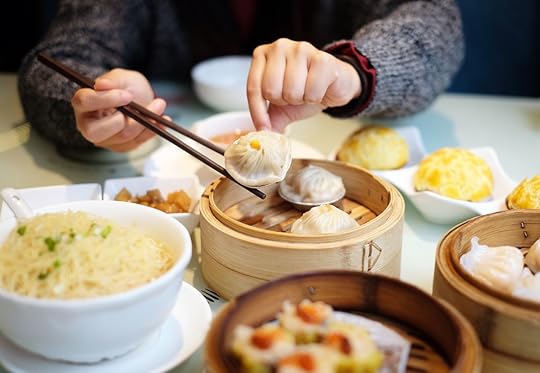
If there’s one meal to eat in Hong Kong, it has to be dim sum. Often mistaken to just mean dumplings, dim sum is actually a selection of small dishes commonly eaten at breakfast or lunch and is best shared among a large group of family and friends. A general rule is that two and a half dishes is the perfect number to order per person, so we say the more the merrier. Found in streetside local eateries and high-end restaurants alike, you won’t have any issues finding options.
These are the must-order dishes for the perfect dim sum experience, as well as a few of the best places to try them in Hong Kong.
1. Siu mai
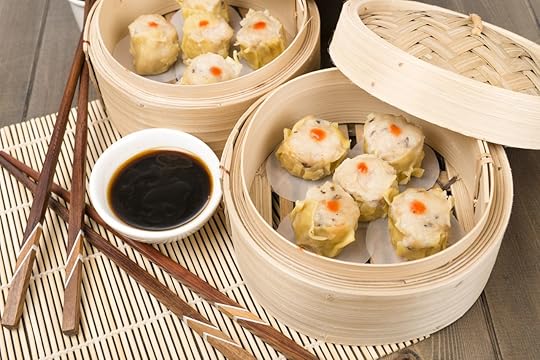
Photo: Paul_Brighton/Shutterstock
This quintessential dim sum dish has found its way into food stalls around the city, but sui mai is one style where you can tell the big jump between the street-food snack version and the quality dim-sum house version. These open-face steamed dumplings contain shrimp and pork and are garnished with bright orange crab roe. Other variations of siu mai contain mushroom instead of shrimp and chicken instead of pork. Dim Sum Library offers diners a contemporary twist on this classic with black garlic pork and shrimp siu mai.
2. Har gow
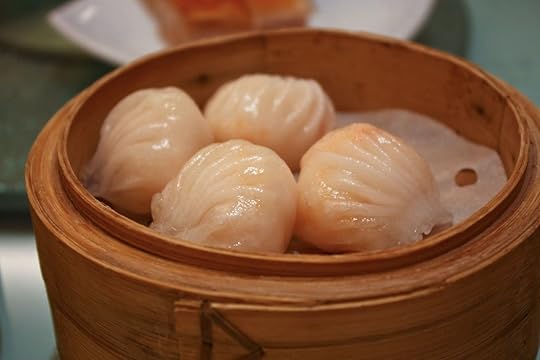
Photo: monotui/Shutterstock
Har gow dumplings live and die by the quality of the shrimp and the translucence of the dough wrapper. These little shrimp dumplings are deceptively simple looking, but the quality of the ingredients — in particular shrimp and bamboo, which creates the creamy texture inside — and the precision required to pleat the dumplings is an art form. Luk Yu Teahouse in Central is one of Hong Kong’s oldest dim sum restaurants, which is the perfect setting to sample such a classic dish.
3. Lo bak go, or pan-fried turnip and radish cake

Photo: Tharnapoom Voranavin/Shutterstock
Not a cake in the Western sense, this dim sum staple is the ultimate comfort food. A traditional dish at Chinese New Year celebrations, radish cake is considered lucky, as its name sounds similar to the Chinese word for “good fortune.” It’s traditionally made with a mix of Chinese sausage or Jinhua ham, dried shrimp, shredded radish, and rice flour. The mixture is steamed and then cut into slices to be pan-fried, which gives it a crispy exterior with soft and spongy insides. It’s usually served with chili XO sauce for dipping to give it some extra bite. One Dim Sum is regularly touted as one of Hong Kong’s top dim sum restaurants, and it certainly doesn’t disappoint when it comes to turnip cake.
4. Cheong fun, or steamed rice rolls
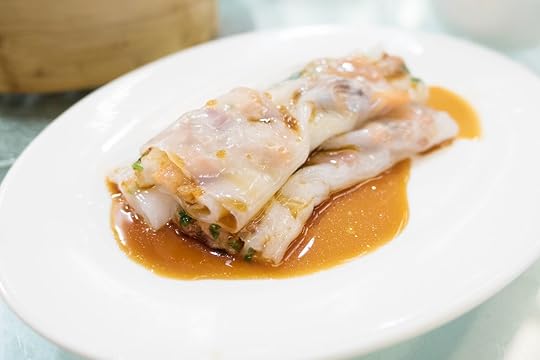
Photo: Bankoo/Shutterstock
These aren’t spring rolls if that’s what you’re thinking. Using glutinous rice flour, these soft thin sheets are rolled around a filling (usually shrimp, pork, or tripe) and served with soy sauce. One of the best variants of this involves a crispy inner casing around the shrimp, which gives an extra crunch to the usually soft texture. Try them at Dim Dim Sum.
5. Char siu bao, or pork buns
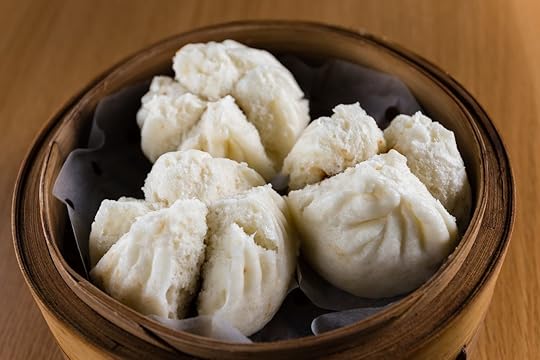
Photo: momo2050/Shutterstock
Even if you’ve never heard of dim sum, there’s a good chance you know of char siu bao, one of Hong Kong’s most famous culinary exports. Char siu is barbecued pork, and the sweet filling perfectly complements the plain, steamed soft white bao encasing it. Hong Kong’s most famous char siu bao can be found at the Michelin-starred Tim Ho Wan, which produces an alternative baked version to this standard street snack, and the bao’s exterior is crispy with a melt-in-the-mouth sweet sugar crust.
6. Custard buns
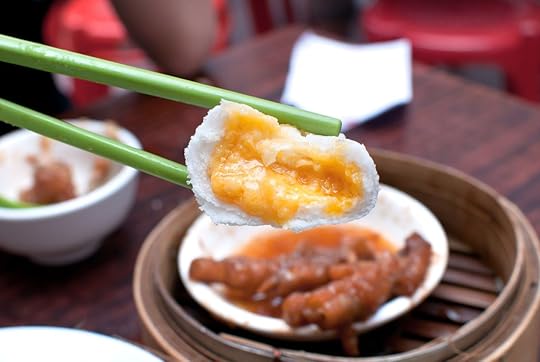
Photo: Stripped Pixel/Shutterstock
Drop any notions of lumpy English custard you have because things are a little different in Hong Kong. The orange molten inside of these fluffy white buns is a rich and sweet egg custard, different from its western counterpart as it often uses condensed milk. The novelty molten custard buns at Yum Cha offer a fun, interactive dining experience, but you can find these buns at any dim sum restaurant.
7. Chicken feet
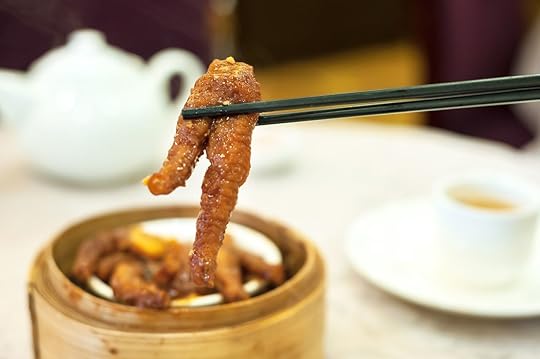
Photo: Stripped Pixel/Shutterstock
While not the most appetizing dish to many Westerners, chicken feet is a dim sum classic that, if you’ve never tried before, should be on your list. It’s traditionally braised with black bean sauce, and the meat is predominantly fatty and skin-like. When cooked well it’s tender, tasty, and can be sucked right off the bone. Often they go by the name phoenix talons, including in Ding Dim 1968 where you can sample this unique Hong Kong dish.
8. Xiaolongbao

Photo: TMON/Shutterstock
This Shanghainese dumpling isn’t a traditional dim sum dish, but you’ll frequently find it on the menu. These steamed dumplings are filled with soup and usually pork, and they’re eaten with ginger and vinegar. Be careful when you take your first bite as the soup inside is usually piping hot — it’s not unusual to see diners poke a small hole in the top to let it cool down first. Din tai fung has reached international fame with its pork xiaolongbao, and these juicy dumplings are certainly worth the hype (and Michelin star). 

More like this: 9 mouth-watering street foods you need to try in Hong Kong
The post 8 essential types of dim sum to eat in Hong Kong appeared first on Matador Network.

The best places in America to try forest bathing
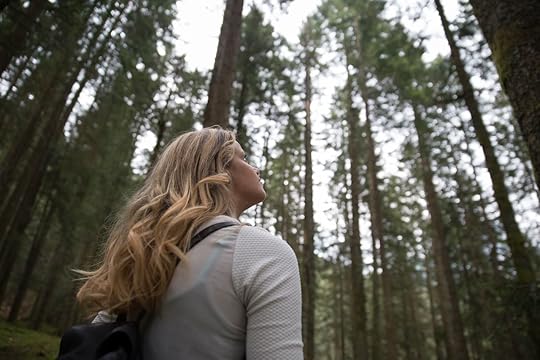
Let’s get something straight: Forest bathing is not a simple walk in the woods. Because let’s be honest, most of us when going for a stroll through the forest bring our phones along so we can document the whole thing, and maybe send some “look how I’m communing with nature” selfies to our friends.
Forest bathing, on the other hand, means truly stopping to appreciate the world around you. It starts with leaving your phone at home, and continues with mindful breathing, touching the earth, and clearing your mind of all the clutter of your life. The Japanese tradition of Shinrin-Yoku has been proven to reduce stress, improve health, and generally make your life better — so much so that the Japanese government has recognized it as a legitimate form of therapy since the 1980s. It’s now catching on in America, and if you’re interested in trying it, here are eight spots around the country perfect for forest bathing.
Humboldt Redwoods State Park, California
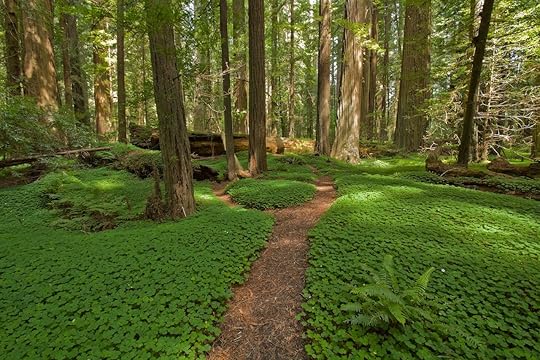
Photo: EyeLights West/Shutterstock
Just driving up Highway 101 to this Humboldt State Park feels calming, where for over 30 miles the highway’s flanked by giant redwoods speeding past. The “Avenue of the Giants” is also chock full of roadside attractions like trees you can drive through and huts carved into trunks. Continue to the park and you’ll be greeted by 100 miles of hiking trails winding through 300-foot redwoods.
Look for the bust of Julia Morgan — the woman who designed Hearst Castle — to find the park’s top forest bathing spot. It marks the trailhead to the Women’s Grove, a loop trail running through a stretch of redwoods that California women chipped in to purchase in 1923. Here you can marvel in the hard red trunks and bask in the shade they provide, while feeling the moisture in the air created by their respiration.
Olympic National Park, Washington
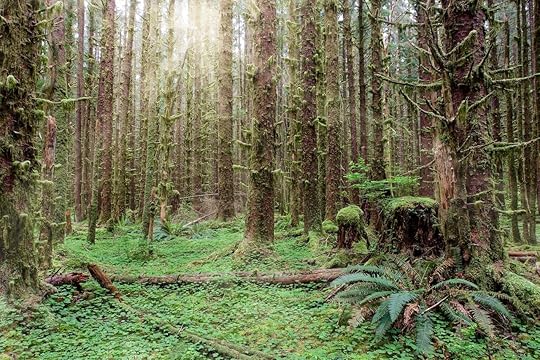
Photo: Roman Tiraspolsky/Shutterstock
America’s only temperate rainforest is full of ferns, mosses, soft grounds, and towering fir trees that will help you escape into the beauty of Western Washington. The forest might literally bathe you, since it gets nearly 140 inches of rain a year. So pack your poncho and step between the old growth trees of the Olympic Peninsula, where you’ll gain wisdom from the Sitka spruces, Bigleaf maples, and western hemlocks that’ve stood for hundreds of years.
The spotted owls hooting overhead are a perfect soundtrack to a mid-afternoon walk, as brief breaks of sunlight shine through the moss-covered branches. Head to Lake Quinault and the Quinault River, where on a sunny day you’ll see the deep blue waters reflecting against a clear sky and emerald trees. Or follow the Sol Duc River to Sol Duc Falls, and relax to the power of the water dropping in the distance.
Poconos, Pennsylvania
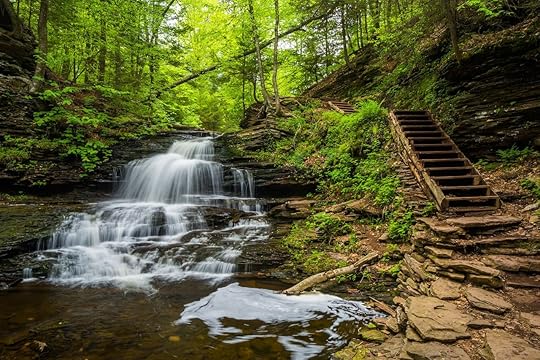
Photo: Jon Bilous/Shutterstock
Forest bathing has become such a hot wellness trend that hotels and resorts have begun specializing in it. Take The Lodge at Woodloch in Pennsylvania’s Pocono Mountains, for example. The lodge employs certified Forest Bathing Specialists (yes, there is such a thing) to take guests on weekly classes through the resort’s 500-acre woodlands. During the class, which lasts about two hours, guests are taught lessons in breathing and mind-clearing while perusing the forest. And can even get the fun started on a meditation labyrinth just outside the main lodge.
Never ones to miss out on a chance to plug the spa, The Lodge also offers forest-bathing-themed spa treatments that include a “deep forest body treatment,” utilizing herbs, dandelion, and birchwood. To keep the mindfulness going, they’ll also send you on your way with information on how to maintain the meditative state so you can forest bathe closer to home.
Great Smoky Mountains National Park
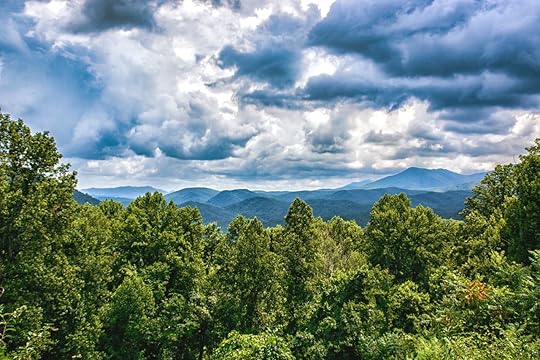
Photo: Jason Hinton/Shutterstock
Skip the hike to Clingmans Dome since during summer the only Serenity it’ll bring is a five-year-old with a weird first name. Instead, hit part of the Appalachian Trail that leaves from the dome towards Newfound Gap. You may find some crowds near the beginning, but they’ll thin out as the trees around you get thicker, allowing you to soak in the moss-covered branches and smell the earth at your feet.
If you’re looking to forest bathe away from the masses, take the Gave Mountain Trial to Hen Wallow Falls. The short, 2.2-mile trail will have you brushing ferns and rhododendrons on your way to the 90-foot falls. Here you can meditate to the sounds of cascading water without voices interrupting, then retreat to your campsite at the trailhead which even during summer is never packed.
Stowe, Vermont
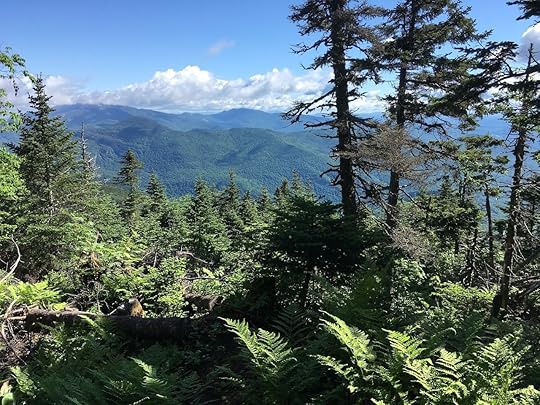
Photo: Laura Knapp/Shutterstock
A place literally called “Green Mountain” just screams for forest bathing, doesn’t it? That’s what the folks at Spruce Peak Lodge think, as the destination ski and golf resort has recently added forest bathing to its list of amenities. The weekly 45-minute excursion takes guests deep into the New England wilderness, where the shade and soil create a blanket of nature worlds away from real life.
In true Vermont fashion, guests are encouraged to walk through the woods barefoot, and though you’ll be expected to clean up before going back inside, the wet ground creates a stronger connection to nature. After teaching you to breathe in the fresh air of the forest, the resort offers follow-up yoga and meditation classes too. So you’ll return from Spruce Peak completely cleansed of whatever stresses you had.
Sedona, Arizona
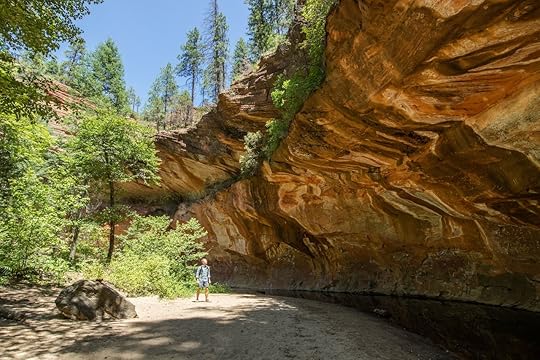
Photo: Sam Spicer/Shutterstock
The Arizona desert might not seem like the place to do anything involving the word “forest,” but the trails in and around Sedona make for the perfect place to escape to nature. The city’s vibe is very much one of mysticism, where energy crystals and psychic readings are more common than gas stations, and otherworldly red rocks surround nearly everything. Taking a walk out to Devil’s Bridge — one of the most photographed sites in Sedona — will have you grabbing onto hard earth as you ascend above a deep green valley. From the top, you can see 360 degrees of clear sky and let the warm, dry air fill your lungs.
For a more forest-like experience, head about 17 miles north of the city to the West Fork Canyon trail. Set along a babbling stream, this short hike brings you through cool trees, under rock formations, and over the water several times. You can wash your feet in the cold mountain creek and slide down bright red boulders while gazing up at walls pushed up from the ocean floor. It’s a variety of nature that lets you appreciate how diverse the planet is, and the ideal place to absorb the world’s energy.
Finger Lakes, New York
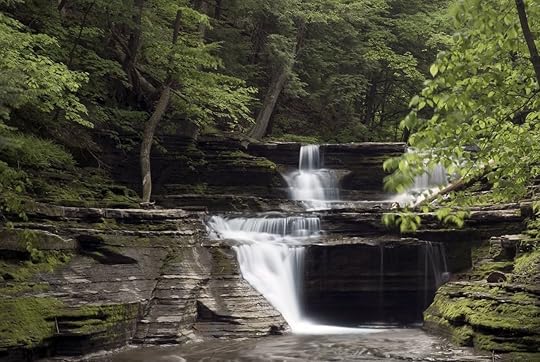
Photo: Michael Shake/Shutterstock
In addition to wine tasting and auto racing, New York’s Finger Lakes are also the perfect place to retreat for forest bathing. It’s one of the first regions in America to develop a region-wide forest bathing program with Finger Lakes Forest Bathing, which offers regular public walks throughout the area. Utilizing the abundant nature of the area, visitors can find almost weekly forest bathing excursions in places like the verdant Bristol Hills and Darien’s Drave’s Arboretum.
Leading you along the way are experts in mental health and horticultural sciences, who can both explain to you the plant life you’re walking through and how to truly step back and breathe it in. Prices are by donation, but your “suggestion” is typically between $40-80. Which might sound like a lot for a walk in the woods, but remember: This isn’t a walk in the woods. It’s forest bathing.
Greensboro, North Carolina
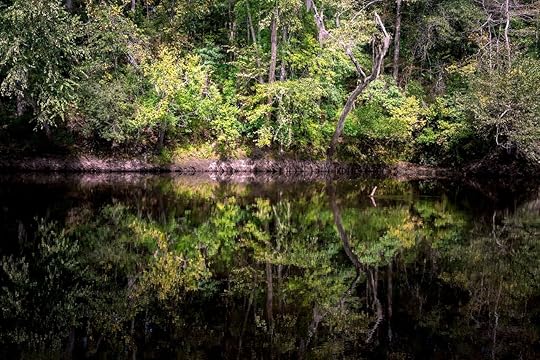
Photo: Serge Skiba/Shutterstock
If you’re going to be North Carolina’s next great destination, first-class nature is a must. And the trail systems around Greensboro deliver, sending you deep into the North Carolina wilderness for a solid afternoon of forest bathing. Though the city’s greenways make for nice morning runs, to get into the thick of it drive a few miles from downtown to the watershed near Lake Brandi. From the road you can jump on the Piedmont Trail, the Palmetto Trail, or many other paths that circle the water.
Almost immediately, you’re surrounded by towering magnolias and pine trees, and as you gaze up at the blue sky between the branches you’ll hear water softly lapping up against the shore. Avoid the blackberry thorns and make your way to the waterline, enjoying the silence of the wilderness as a warm southern breeze hits your face. Along the trail, you’ll find clearings with sprawling meadows and colorful flowers, the perfect spot to literally stop and smell them all. Though a trip to Greensboro is never something you’d describe as “hectic,” the trails near the city still provide a perfect escape. 

More like this: The Japanese practice of ‘forest bathing’ can actually lower your blood pressure
The post The best places in America to try forest bathing appeared first on Matador Network.

The most famous works of I.M. Pei

One of the most influential architects of all time, I.M. Pei passed away on Thursday at 102 years old, leaving behind a legacy that won’t soon be forgotten. The Chinese-born architect was responsible for some of the world’s most famous and widely recognized pieces of modern architecture, and you may have marveled at some of his works without even knowing it. He is perhaps best known for designing the East Building of the National Gallery of Art in Washington and the Louvre’s glass pyramid, and he was in high demand by both real estate developers, CEOs, and art museum boards for his striking designs. Here are a few of his most iconic buildings.
1. Everson Museum of Art, Syracuse
View this post on InstagramA post shared by Everson Museum of Art (@eversonmuseum) on Apr 24, 2019 at 1:59pm PDT
Pei’s first-ever museum commission, this museum was completed in 1968 and strove to totally redefine museums altogether. Before, museums were simply considered vessels for art and culture and did not themselves warrant any special, creative design. Pei changed that. The Everson Museum’s website says that Pei “rejected the traditional notion that a museum needed to be a monumental container for art and decided it ought to be a sculptural work of art in itself.” The museum itself became an attraction, setting a high standard for museum designs that came afterward.
2. The Louvre Pyramid, Paris

Photo: Valikdjan/Shutterstock
The Louvre’s glass pyramid is one of the most well-recognized monuments in France, if not the whole world. The pyramid wasn’t always as appreciated as it is today, however, and initially Pei was derided for altering one of the world’s great landmarks. Critics hushed after its opening in 1989, and Pei himself said, “If there’s one thing I know I didn’t do wrong, it’s the Louvre.” Indeed, the Louvre never stopped appreciating the contribution, saying on their official website, “He was able to inspire a great enthusiasm within the teams of the Louvre Museum throughout this vast project. His incredible smile marked the spirits. On the occasion of the awarding of the Pritzker Prize (1983), he declared: ‘The Louvre is the kind of challenge that is only taken once in a lifetime’”.
3. Rock and Roll Hall of Fame Museum, Cleveland
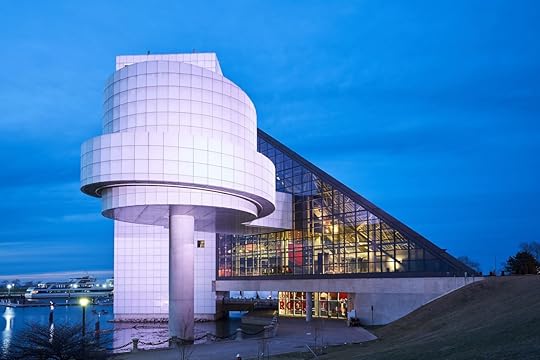
Photo: Showcase Imaging/Shutterstock
Since Pei wasn’t a rock and roll fan, he initially turned down this commission. When he eventually accepted it, however, he traveled with Jann Wenner, co-founder of Rolling Stone Magazine, to rock concerts all around the country to spark inspiration for the design. The Rock and Roll Hall of Fame Museum was completed in 1995 in Cleveland, and its sloping shape makes it classic Pei.
4. East Building of the National Gallery of Art, Washington DC
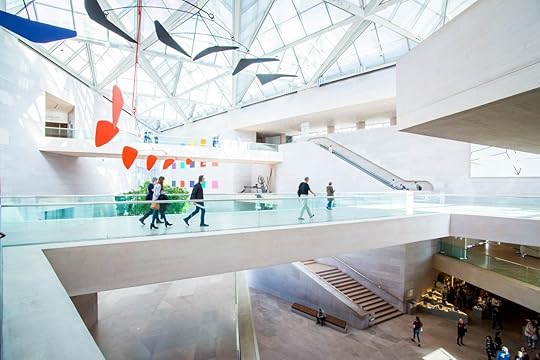
Photo: mervas/Shutterstock
This building is famous for its sharp, angular forms, as well as its glass and marble construction. Finished in 1978, it is situated around a triangular courtyard and was truly a tour de force in artistic modernism. With the East Building, Pei sought to prove that modernism could produce works as permanent and grand as more traditional styles. According to an article written right after its opening, by The New York Times’ then-senior architecture critic Ada Louise Huxtable, the East Building was “one of the most important and conspicuous in Washington.”
5. Museum of Islamic Art, Doha

Denver decriminalizing mushrooms

The rising national movement against drug prohibition took a major step forward on May 7. Voters in Denver, Colorado, narrowly passed a measure to decriminalize psychedelic mushrooms — effectively making them law enforcement’s lowest priority in the city. Signs around proclaiming support for Initiative 301, or I-301 as it became known, were an increasingly common sight in Denver leading up to the election, but still, the vote was close. The initiative passed by just 2,291 votes in a city of more than 600,000. Denver became the first municipality in the United States to take this step, and many residents are already drawing comparisons between the budding psilocybin movement and the 2012 passage of Amendment 64, which legalized recreational marijuana in Colorado. Whether or not those behind I-301 realize similar success in the future, one thing is clear: This initial step is huge.
What exactly does “decriminalize” mean?
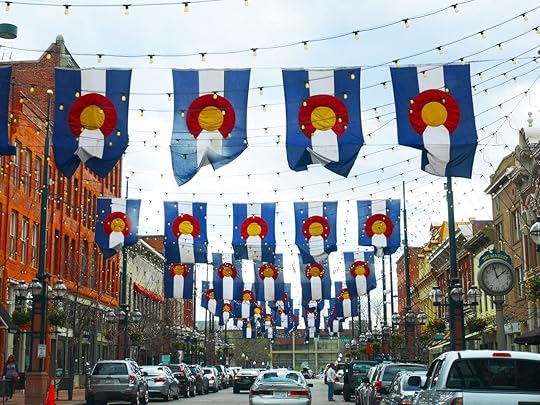
Photo: orientalprincess/Shutterstock
Don’t rush to the 16th Street Mall with a mug of mushroom tea just yet. Magic mushrooms are set to be decriminalized, not legalized. The measure moves the personal possession and personal use of mushrooms by persons age 21 and over the city’s “lowest law enforcement priority.” Financial resources and staff will not be used to pursue or impose criminal penalties against those in possession of them. Police will be directed to look the other way unless someone is openly selling magic mushrooms to others or disturbing the peace.
“The biggest impact on gathering public support was emphasizing that this is decriminalization and that people will no longer face severe penalties for possession and use of psilocybin,” said Kevin Matthews, Campaign Director for I-301. “A lot of the confusion we faced was voters thinking that there would be shops where residents could purchase mushrooms. According to the new law, sales and distribution are still highly illegal.”
This movement certainly wasn’t born of hippies nor free-wheeling college students holding signs in a park. Rather, it began in the offices of the Food and Drug Administration, who in October 2018 granted psilocybin “breakthrough therapy” designation for its potential as a treatment for cancer patients with depression or anxiety. This meant that the administration had analyzed and approved the results of prior medical studies on the potential effects psilocybin offered clinical patients to treat conditions such as depression and anxiety. The group wanted more research done, and they wanted it prioritized.
Matthews and other campaign organizers worked to promote this medical promise much in the way that the medical marijuana movement found traction. Initiative 301 actually has the FDA at least somewhat on their side, it appears — something cannabis didn’t, and still does not, have. “The FDA has not approved marijuana as a safe and effective drug for any indication,” the agency says on its website, though they note the caveat of cannabidiol for “treatment of seizures associated with Lennox-Gastaut syndrome or Dravet syndrome in patients 2 years of age and older.”
Initiative 301 supporters also pointed critics to the fact that psilocybin is not addictive and, also like cannabis, there has never been a documented overdose. They also drew attention to the growing base of scientific evidence pointing to the drug’s ability to treat medical disorders. “301 is for personal possession and use only,” Matthews said. “Also, when we shared about the tremendous medical potential of psilocybin and mentioned universities like Johns Hopkins and NYU who’ve conducted research, many voters either changed their minds and supported us or were encouraged to do their own research.”
How this step compares to the marijuana legalization movement
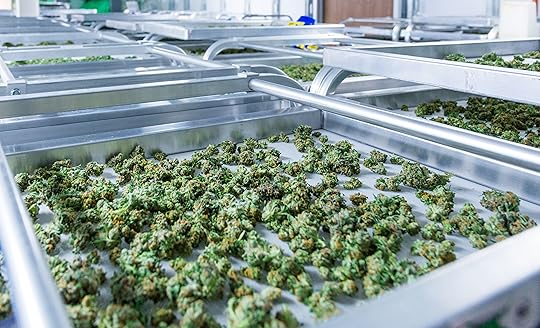
Photo: Mitch M/Shutterstock
Most Denverites aren’t in favor of tripping burnouts wandering the city’s streets any more than they’re in favor of hotboxed cars in grocery store parking lots. Denver Mayor Michael Hancock came out against the measure, as did the city’s District Attorney. But the Denver Police Department declined to take a stand, and late polling showed that psilocybin’s potential medical benefits are slowly catching mainstream appeal.
“I voted for the measure because of how well Denver rolled out its cannabis decriminalization and legalization,” said Andrew, a Denver resident since 2010 who also voted in favor of cannabis legalization on the 2012 ballot. He wished to have his last name withheld to remain anonymous. He believed the city and state handled the legalization of recreational marijuana in a manner that benefits the economy and keeps the black market from controlling the substance. He added that “someday, I’d like to hallucinate legally.”
Not everyone is taking the parallels between the two substances so lightly, however. Activist groups have sprung up against I-301, some on religious grounds and others fearful of what they see as a growing tolerance of illicit drugs in the city. “In 2012, when opponents of marijuana legalization said that lax attitudes towards marijuana would lead to lax attitudes towards other drugs, we were laughed at,” said Colton Grace in an email release from the group Smart Approaches to Marijuana, which actively opposes marijuana legalization and feels the same way about this measure. “Well, no one is laughing now.”
Major business interests are already on board.

Photo: Creative Family/Shutterstock
Beyond civilian activism on both sides, psilocybin is also attracting investment money, and lots of it, from both the medical space and Silicon Valley. Before a movement can really take hold, it needs someone big to stand behind it. As fledgling as the psilocybin legalization movement is compared to other recent groundswells like cannabis or ride- and home-sharing, it does have one notable backer: Peter Thiel, who was also the first major investor in a small social networking site called The Facebook.
In 2016, Thiel backed a startup called Compass Pathways in its pursuit of tests on the effects of psilocybin on patients with mental illness, including depression, for which mainstream treatment methods have failed to produce results. The company will be conducting clinical trials in several European countries alongside research organization Worldwide Clinical Trials.
“We need a new approach to tackling mental health,” said Compass Pathways co-founder George Goldsmith in a statement picked up by newswires across the country. “Current treatments for depression work for many people, but there is still a significant unmet need for a large number of patients living with this very challenging condition.”
The support of Thiel and other big-name investors from the US and Europe is driven by recent scientific studies that have already taken place, including one undertaken by the Beckley Foundation in 2016, showing that psilocybin may actively boost the happiness levels of patients suffering from depression. In the study, 20 patients over the age of 18 were given oral doses of psilocybin on two occasions, separated by seven days, and the results were measured after five weeks, three months, and six months. The study found that, particularly at the five-week interval, depression levels had subsided noticeably, and noticeably without negative side effects or the need for other treatments beyond psilocybin. The line of thinking of those involved in decriminalizing the substance is that the compound could potentially be used as a mainstream treatment for depression, particularly in cases where traditional treatment options have failed to produce positive results.
What happens next?
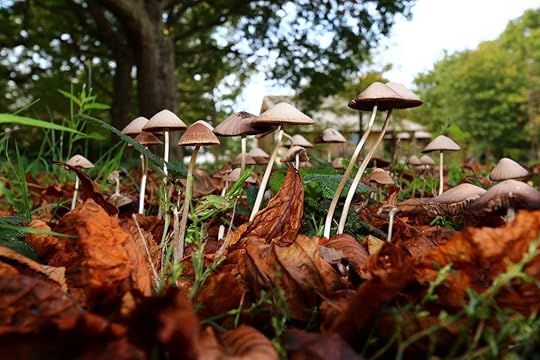
Photo: The Naked Eye/Shutterstock
As we noted above, the vote in early May made Denver the first city in the United States to decriminalize psilocybin. In this context, “decriminalize” is basically just a fancy way to say that Denver’s voters don’t want law enforcement resources going toward chasing people with a bag of mushrooms in their pocket, as long as they are over 21. Any current financial or personnel commitments working in this manner, if there are any, will be redirected to other causes. The Denver Post reported that 158 people were arrested in the city between 2016 and 2018 for possession of mushrooms, and in the first three months of this year, fewer than 2.5 pounds of the drug were confiscated by offers. So this measure won’t directly affect very many people, but it might take a bit of stress off the casual user.
“Now that the campaign has passed our focus turns toward implementation and education,” Matthews said. “301 was certified (on May 16) in Denver, and we will be watching the runoff races very closely over the next few weeks, speaking with candidates, and asking whether or not they will go on record and state that they will support the will of the voters. We intend to sit down with the city attorneys office, the DA, and law enforcement and make available resources and harm reduction tools they’ll need to better understand psilocybin.”
The effect of the ballot measure is to be monitored by the formation of a “mushroom policy review panel” comprised of police department staffers, city council members, various legal representatives from city departments, and an addictions counselor. The group has yet to begin work, and it’s far too soon to tell whether this measure will have a broader impact on Denver drug policy or if life will carry on as usual. The movement opposing decriminalization actually led the tally as early results posted. Multiple local media outlets reported on evening news programs that the measure had been shot down, only to retract their findings the following morning after absentee and military ballots had been counted, along with the last of the remaining regular ballots.
In short, Denver isn’t going to have a legalized market for fresh magic mushrooms anytime in the near future. But this vote could lay the foundation for more sweeping legalization measures to come in the future. The city’s recreational cannabis industry began in much the same way back in 2005, with an initial decriminalization measure passing seven years before the 2012 vote brought recreational legalization. “Overall, being honest about the risks and highlighting the benefits was key, and having our education messaging aligned over social media and speaking directly with Denver residents is what had us win.” 

More like this: No, CBD is not legal in all 50 states
The post Denver decriminalized magic mushrooms. Here’s why this is huge. appeared first on Matador Network.

Taco Bell hotel opening

We’ve heard of chain restaurants and chain hotels, but what about a chain restaurant hotel? Taco Bell is taking steps to make it a reality by opening The Bell: A Taco Bell Hotel & Resort in Palm Springs, Florida. This temporary hotel takeover is an attempt by Taco Bell to cater to its most diehard fans and create an experience beyond simply food.
The hotel is rumored to feature a gift shop with Taco Bell-themed apparel, a salon with nail art and hair styling services inspired by the fast-food chain’s offerings, and, of course, a Taco Bell restaurant.
According to the hotel’s website, “Complete with exclusive Taco Bell menu items and plenty of surprises, The Bell is sure to be the spicy twist of your summer. So pack your swimsuit, mark your calendars and start the countdown, because The Bell is about to make all of your taco dreams come true.”
The hotel is Taco Bell’s attempt to not only create brand awareness but also a unique, unparalleled experience for its existing fans. And it’s certainly not the first time. The chain has also offered to marry customers for $600 at its Las Vegas Cantina location (and yes, 165 couples registered). They have also partnered with Forever 21 to sell branded clothes with Taco Bell’s logo.
The lucky hotel that will host the takeover has yet to be named, but reservations will open in June, with guests able to check in starting on August 9. You can sign up to be notified when reservations go live. 
H/T: CNBC

More like this: The 9 coolest fast-food locations around the world
The post A Taco Bell-themed resort is opening in Palm Springs appeared first on Matador Network.

Best coffee spots in Vancouver
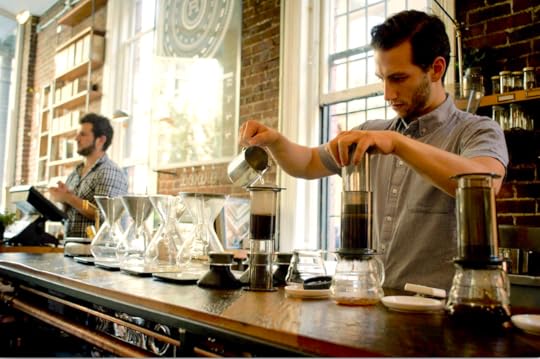
In a city hyped for its cuisine and its craft beer, the real down-low is Vancouver’s coffee. Firmly into the third wave, Vancouver roasts, pours, and pulls as well as the top coffee cities in the world. And even still, Vancouver’s already mature coffee culture is growing better by the moment.
If you’re just starting to learn about the intricacies of coffee and are moving slowly away from milk drinks and burnt dark roasts, Vancouver is a super place to learn more. If you’re an insufferable coffee snob, there’s no need to be ashamed around here.
While some Vancouverites tend toward the taciturn, it’s possible to strike up a good conversation with a barista or a fellow enthusiast while you sip. One of the easiest places to meet people who share a coffee passion is at the annual Hopwired Festival, which blends the best of two compatible worlds: beer and coffee. Hopwired showcases both small-batch roasters in British Columbia plus the BC brewers who use bespoke beans in their beer.
If you can’t make it to the festival, you can do worse than going to any one of the following places.
The best coffee shops in Vancouver

Photo: Nemesis Coffee/Facebook
Revolver: Known around the world for carrying an elite selection of boutique beans, Revolver deserves a lot of credit for putting Vancouver on the third wave coffee map. When you walk in, the space feels tight, but there’s a sizable second room where you can sip. All the prep methods, including espresso, are fantastic, but the real beauty here is the array of bagged beans from roasters in places like Sweden and South Korea.
Nemesis: Pulling one of the better shots in town, Nemesis offers a minimalist aesthetic in an airy open space that’s great for working or catching up with friends. As with Revolver, beans come from all over the world.
Aubade: You’d think Vancouver invented cool when you pop into Aubade, which is little more than a kitchen counter plopped inside a cluttered antique store in the heart of Chinatown. Browsing bric-a-brac while the barista brews is part of the charm at this one-man operation. As if all that isn’t enough, the preferred brewing method here is the Aeropress. It’s close to Matchstick Roasters, so you can caffeinate your way through Chinatown.
The best coffee roasters in Vancouver

Photo: Rocanini Coffee Roasters Mount Pleasant Roastery/Facebook
Coffee lovers visiting Vancouver have to check out at least one of the city’s micro-roasters. Roaster outlets are as accessible to noobs as they are to nerds, so take a shot at one of these.
Rocanini: Rocanini sets itself apart by offering beans from countries you don’t normally see represented on shelves — like Yemen, Rwanda, and Burundi. The only real drawback with Rocanini is that the beans tend to cost more than all competitors in Vancouver, but that won’t stop enthusiasts from buying a bag or stopping in for an espresso shot. If you have the time, visit the flagship cafe and roaster out in the cute fishing village of Steveston.
Elysian: Despite having expanded to several locations around Vancouver, Elysian has not even come close to losing its character and penchant for near-perfect roasting. Locals love the ever-changing selection of single-origin beans. Locations tend to be conveniently located all about town, including in Kits, Downtown, Cambie & Broadway, and Mount Pleasant.
Matchstick: The coffee here is on par with the other local roasters in Vancouver, but it also happens to bake a dark sourdough that’s one of the best loaves of bread in the city. Plus, Matchstick has craft beer on tap. The flagship Matchstick is in Chinatown, but Fraser Street, Yaletown, and Riley Park are also blessed with outposts. Beer, bread, and beans: Matchstick has it all.
Modus: In a part of town that can feel aloof, you’ll breathe a sigh of relief when you step into this comfy shop located on Broadway just a few blocks west of Main Street. Modus is charming with only a few places to sit, but the beans are meticulously roasted each Monday to bring out the finest features in each variety.
Moving Coffee: If you want to soar straight to heaven, saunter on down to Moving Coffee. This is the quintessential new-gen nano-roaster. Forget about the laptop or even moving in this teensy tiny place that shares space with an equally wee bakery in Mount Pleasant. Moving has managed to stay cool under the radar, but people who live or work in the area know about it well enough. There is nary a place to sit here, but coffee geeks will love it for the genuine enthusiasm for coffee the owner/roaster/bean-grader/barista will share when you start talking shop.
49th Parallel: Not to be confused with craft beer darling Parallel 49 — to play on their names, 49th Parallel and Parallel 49 once teamed up for a one-off coffee beer — 49th Parallel Coffee was one of the earlier entrants on the Vancouver coffee scene. Although larger in scale than most of the other roasters on this list, 49th Parallel still turns out small-batch roasts of regularly rotating beans and blends. The shiny new digs in the downtown central business district is bound to be a crowd pleaser for coffee lovers who can’t visit some of the other roasters. 

More like this: The best bars and nightlife in Vancouver right now
The post Where to find the best coffee in Vancouver appeared first on Matador Network.

What it's like to take mushrooms

With the recent decriminalization of magic mushrooms in Denver, you may be thinking of paying a visit to the city sometime soon. Magic mushrooms have been making headlines over the past few years as more and more studies are showing the potential benefits. However, it’s important to keep in mind that these studies are done in controlled, clinical environments. To ensure you have a positive experience in a recreational setting if you plan on giving them a try in Denver, there are some things you need to keep in mind.
What are magic mushrooms?
Magic mushrooms, also known as shrooms, is the term most often used to describe any species of mushroom containing psilocybin. This is the chemical responsible for the hallucinogenic effect when eaten. Psilocybin binds to serotonin receptors in the brain, which then alters your mood and perception. They grow naturally all over the world in moist environments, although the ones you are most likely to come across are cultivated by a grower.
The experience
Magic mushrooms can take you on a powerful psychedelic journey. Everyone experiences them differently, and many factors can influence a trip. Generally, there are a few things you can expect from an average dose. Your perception of everything around you will change. All your senses will be heightened. Visually, you will hallucinate geometric or fractal-like patterns. Objects may morph, become distorted, or seem as if they are alive. You may also have some closed-eye visuals.
Mentally, you may feel as if you have left this reality. Time and space become very distorted and sometimes feel as if they don’t even exist. You may feel euphoric, emotional, and more open to your thoughts. Many also report their trip as a mystical or spiritual experience. In a study of 18 participants at the Johns Hopkins University School of Medicine, 61 percent said the psilocybin experience was “the single most spiritually significant [experience] of their lives,” while 83 percent rated it in their top five.
What to know before taking shrooms
Set and setting is one of the most important factors in preparing for any psychedelic experience.
Set refers to your mindset going into the trip. Make sure you are feeling happy and healthy. Don’t have any important commitments for the rest of the day, as this may stress you out. If you are not feeling good about something in your life, it can negatively affect your trip. It is highly recommended to set intentions for your trip. Ask yourself why you want to take magic mushrooms and what you hope to gain from the experience.
Setting refers to the physical environment in which you will take them in. What’s most important is that you are doing them somewhere where you feel comfortable. If you do them with others, make sure they are people whom you know well and trust. Ideally, do them in a safe space where you can sit or lie down, not be too warm or too cold, and have easy access to water, a toilet, and anything else you might need for the day. Also, try to go outside for at least a portion of your trip.
Dosage is also very important. If this is your first experience with magic mushrooms, start small. Remember that you can always eat more, but if you’ve taken too much, you can’t eat less. Tripsit recommends 0.8 grams of dried mushrooms to start off. A common dose is 1-2.5 grams, depending on the potency and strain of your mushrooms.
The entire experience can last about six to eight hours. Keep in mind it might take a couple of hours for them to really kick in.
Risks
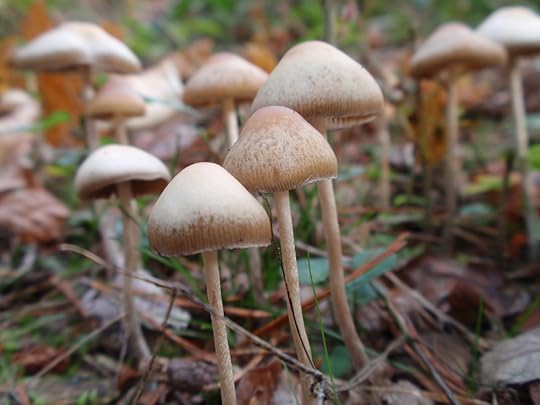
Photo: Petr Pe/Shutterstock
The most common risk associated with taking magic mushrooms is having a bad trip. For some, they can cause confusion, fear, anxiety, and paranoia, and this can make the experience quite overwhelming. Set and setting are key for minimizing the risk of these feelings, but even then, sometimes they do occur. The Zendo Project, a psychedelic harm reduction group, states that, “Difficult is not the same as bad.” Rather than fighting these feelings, it is usually better to “let go.” A difficult, or challenging trip may be happening for a reason and may lead to learning and personal growth.
Another study at the Johns Hopkins University School of Medicine outlines guidelines for safety in its hallucinogen research. These same guidelines should be followed for recreational usage:
If you or your family have a history with schizophrenia, bipolar disorder, or other psychotic disorders, you should avoid magic mushrooms, as they can up the chances of developing prolonged psychosis.
You also should not mix magic mushrooms with any drugs that affect the serotonin system. For example, certain antidepressants, SSRIs, or serotonin supplements such as 5-HTP. Certain recreational drugs can also be dangerous. Tripsit has a great drug combination checker online.
There is also the risk of developing hallucinogen-induced persisting perception disorder, or HPPD. Essentially, this is when a user experiences hallucinations or “flashbacks” after the trip is over. However, reported cases of this disorder are rare.
Potential benefits
Magic mushrooms have most notably been proven to help with depression. In fact, the US Food and Drug Administration (FDA) designated psilocybin as a “Breakthrough Therapy” for depression in 2018. The study states, “Preliminary clinical evidence shows that it may demonstrate substantial improvement over available therapy.”
A study done at the South Dakota State University College of Pharmacy has also shown psilocybin can help with suicidal thoughts, anxiety, obsessive-compulsive disorder, alcoholism, and tobacco dependence.
But there are many benefits even for those not struggling with any of the above. Magic mushrooms have a high potential for long-lasting personal growth. In a one month follow-up of the Johns Hopkins study of 18 participants, 94 percent of volunteers said the experience “increased their sense of well-being or life satisfaction moderately or very much, and 89% rated moderate or higher changes in positive behavior.” The ratings remained high even 14 months after. “The types of behavior change most frequently cited by volunteers were better social relationships with family and others, increased physical and psychological self-care, and increased spiritual practice.”
Magic mushrooms have been ranked as the safest recreational drug by the 2017 Global Drug Survey. If you plan on using them recreationally, remember the risks and properly prepare for your trip in order to reap the full benefits. 

More like this: Denver becomes the first city in the US to decriminalize magic mushrooms
The post Everything you need to know about doing magic mushrooms appeared first on Matador Network.

Cheap flights in June
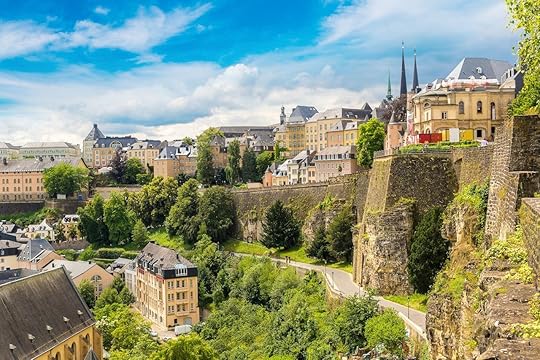
The South always likes to do things a little…different. If you live there, you know this already. If you don’t, well, you’ve probably figured it out from years of Jeff Foxworthy jokes and college football reaction videos. Fried food. Sweet tea. Using “Bless her heart” as a polite way of saying “She’s as dumb as a box of rocks.” The South is, if nothing else, a special little corner of America. And if you haven’t spent good amounts of time there, you probably don’t understand a thing about it.
Well, good news, not-so-domestically-well-traveled traveler! Coming up this June, flights all over Dixie will be dropping like Spanish moss off a live oak tree. We talked to our friends at Skyscanner, who looked at painful amounts of historic flight data to find the cities where airfares are predicted to go down in June. And wouldn’t you know it, for once the South came out on top.
The darlings of Southern culture — Savannah and Charleston — take two of the top three spots this month, with fares down 12 percent and 7 percent respectively. If a southern beach vacation is more your style, you can do it on the cheap in Myrtle Beach, where flights drop 6 percent to $192. You can also visit the home of Lynyrd Skynyrd, which is actually not Alabama but Jacksonville, Florida, where airfares are down 3 percent to $304. The rest of the domestic leaders below the Mason-Dixon:
Savannah, Georgia — $268 (12%)
Austin, Texas – $272 (7%)
Charleston, South Carolina — $302 (7%)
Myrtle Beach, South Carolina — $192 (6%)
San Juan, Puerto Rico — $328 (5%)
San Antonio, Texas — $308 (5%)
Key West, Florida — $423 (3%)
Jacksonville, Florida — $304 (3%)
Orlando, Florida — $238 (2%)
Memphis, Tennessee — $344 (1%)
If you live in the South, or it’s just a little too foreign for you, plenty of international destinations will have cheap flights too. Head south…of the border to Cozumel, which leads the overseas pack with flights down 12 percent to $467. If “the South” to you means Southern Hemisphere, June is right up your alley too. Cordoba, Argentina will see airfares down 9 percent to just a smidge over $1,000. But steaks and wine cost like a nickel there, so this will be your biggest expense. Or check out Salvador, Brazil, where a trip will cost you $884, a full 9 percent cheaper than it would be in May.
Cozumel, Mexico – $467 (12%)
Salvador, Brazil – $884 (9%)
Cordoba, Argentina – $1,038 (9%)
Yangon, Myanmar – $945 (8%)
Siem Reap, Cambodia – $801 (7.%)
Chiang Mai, Thailand – $796 (6%)
Luxembourg – $782 (5%)
San José del Cabo, Mexico – $389 (5%)
Hanoi, Vietnam – $925 (5%)
Marsh Harbour, Bahamas – $445 (4%)
So pack up your bug spray and stock up on Lipitor, it looks like the South is going to be in your near future. Just try not to think too hard about how many calories are in your food. 

More like this: The best places to travel this July
The post Flights to these 20 cities are about to drop hard in June appeared first on Matador Network.

Trucks can charge on Germany highway

Hybrid trucks are about to rule the road in Germany, with the installation of new “electric highways.” The country has just introduced its first stretch of an electric highway, a six-mile stretch of the autobahn south of Frankfurt, fitted with overhead wires that allow trucks to recharge on the go. Munich-based engineering firm Siemens AG is responsible for the system, which uses technology similar to trains and trams. Trucks can link up to the wires and drive while continuously receiving electricity to their battery. When the electric segment of the road comes to an end, the truck can continue driving on battery power.

Photo: Siemens
According to Siemens, ehighways can save a 40-ton truck $22,000 over 62 miles of driving. Rita Schwarzelühr-Sutter, parliamentary state secretary of the Federal Ministry for the Environment, Nature Conservation and Nuclear Safety, said, “Electrified overhead line trucks are a particularly efficient solution on the way to climate-neutral freight transport. We’ve tested the system for many years on private test routes. We’re now inaugurating practical tests on the A5 autobahn between Frankfurt and Darmstadt, and two further test stretches will follow in the States of Schleswig-Holstein and BadenWürttemberg.”
The project was funded by Germany’s Federal Ministry for the Environment, costing around $16.4 million, plus an additional $17.2 million for field trials in the state of Hesse. 
H/T: Bloomberg

More like this: The 8 most amazing, sustainable restaurants in the world
The post Germany introduces ‘electric highways’ which charge trucks on-the-go appeared first on Matador Network.

How to raft the Owyhee River
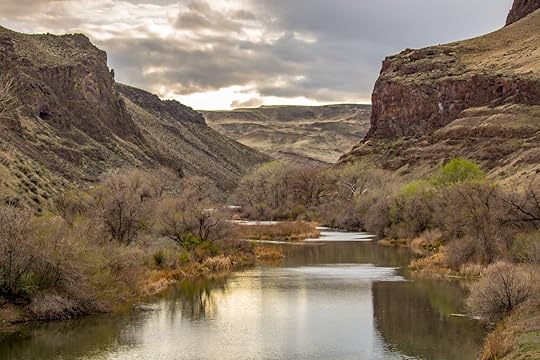
Unlike many rafting trips that start with epic views of a big mountain objective, the put-in on the Owyhee River is unassuming. The start of this classic excursion lies at a small, grassy landing at the end of a dirt road near a tiny speck of a town called Rome in eastern Oregon. This Bureau of Land Management (BLM) land has more open-range cows than humans — but don’t let this fool you. The Owyhee, not far from the border with neighboring Idaho, is one of the best-kept secrets in the country, visited mostly by locals and in-the-know river-riders in the Pacific Northwest. If you only plan one rafting trip this summer, this should be it. Here’s how to make it happen.
Where is the Owyhee River?
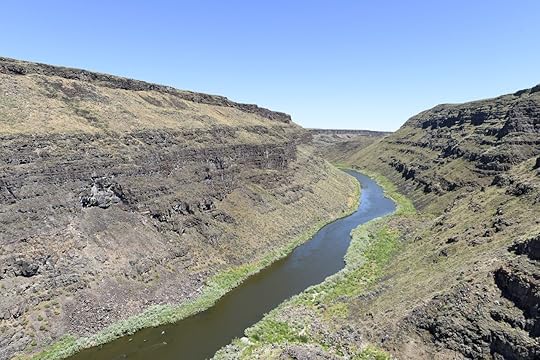
Photo: Hugh K Telleria/Shutterstock
A winding, snow-fed roller coaster on the border of Oregon and Idaho, the Owyhee flows north and sits deep in a canyon often referred to as the “Little Grand” by locals. Due to the remoteness and lack of information about it online, it’s rarely paddled, despite being one of the best Class III-IV runs in the country. Most of eastern Oregon is a remote high desert, with no major cities and few towns.
This is one of the largest undeveloped areas in the lower forty-eight, similar to west Texas or desert parts of Utah and Nevada. To many, the ruggedness is one of the biggest draws to the area. A rafting trip here is the perfect chance to escape civilization for a few days and revel in the sounds, smells, and silence of the natural countryside.
Most of the vegetation is low-lying sagebrush and other similarly hardy plants. As you paddle downstream, the walls of the canyon grow, eventually hanging a thousand feet above you. The entire Owyhee is 346 miles long, from its headwaters in northern Nevada, through southern Idaho, and to its entry into the iconic Snake River in Oregon. In the canyon, you’ll see juniper and willow trees, as well as many types of grasses. If you get lucky with timing in the spring, you may catch full bloom when the canyon is covered in various colors.
Planning the trip: routing and logistical considerations
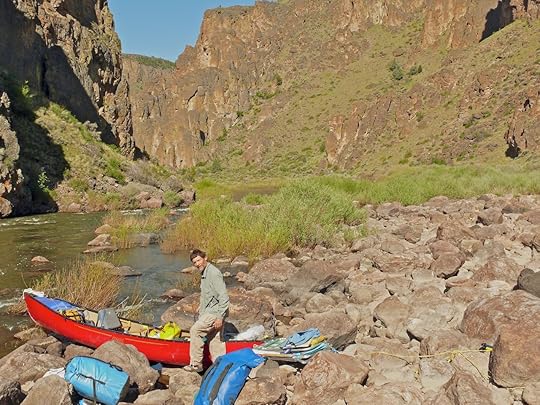
Photo: Roze Petal/Shutterstock
The best time to paddle the Owyhee is throughout May and June when the water level is highest. If you’re early enough, you might just catch the full bloom, but the canyon is photogenic no matter when you’re there. The ideal route takes you through the section of the Lower Owyhee from Rome to Birch Creek, which runs 48 miles. This route sends you through one of the most scenic and stunning stretches of the canyon, with various colors of rock stacked on both sides of the river.
Paddling the route typically takes three to five days from start to finish, depending on your skill level and how often you decide to get out of the boats to hike side canyons. Many other options for off-shoot river trips exist for folks who want to explore further into the side canyons and runoffs. Trips are possible on multiple forks and tributaries of the Owyhee, many of which could be attached to the main path for excursions longer than a week.
The brand Oregon River Experiences has made a full list of put-ins and maps, which you should reference when planning ins and outs, and where to camp each night. For all of these, flows are critical, as they often dry up in sections as the season progresses. Of course, because of the remoteness of the entire river, don’t expect cell service or help from outside. Proper planning is critical.
Weather-wise, take note that, like most canyons, temperatures can range dramatically. It’s not uncommon to experience both below-freezing lows and highs in the 90s or higher, even in the same day. It’s important to plan accordingly — bring multiple layers, spare clothes, and pack your stuff into dry bags when on the river. The Owyhee is well known for unpredictable weather year-round, often changing 40 or more degrees from day to day. Sunscreen is a necessity.

Photo: CSNafzger/Shutterstock
For private trips, permits are relatively easy — as self-registration through the BLM. Designated as a Wild and Scenic River in 2009, the Owyhee River is surrounded by over a half-million acres of protected wilderness. The protection of this area took 30 years, largely due to mining and grazing interests that fought to keep the land in private hands. The full run-down on permit information and regulations is available from the BLM.
Dozens of options for places to camp lie along the river, from sand bars to grassy knolls. Hike-out Camp at mile 14 is a great site for the first night, with a trail up the canyon to the rim. Lambert Dome at mile 26 is a great second night, with some of the best views of the canyon, or continue to Point Canyon around mile 31. At mile 43 you’ll paddle past hot springs on your left, just upstream from Greeley Bar Camp. Stays here are limited to one night.
Shuttling cars between the put-in and take-out requires that you have two vehicles, ideally both of which are four-wheel drive. The road to the put-in and take-out can be rough, and it takes about two hours to drive between the two. Some of these roads can be closed after a big storm, though you won’t want to be on the river if a big storm comes in anyway. That said, beware the risk of the getting your car stuck in the mud. And despite remoteness, don’t leave valuables in your car. The closest airport is Boise, roughly two hours away. Bend, Oregon, is four hours away and Portland is roughly seven hours by car.
On the river
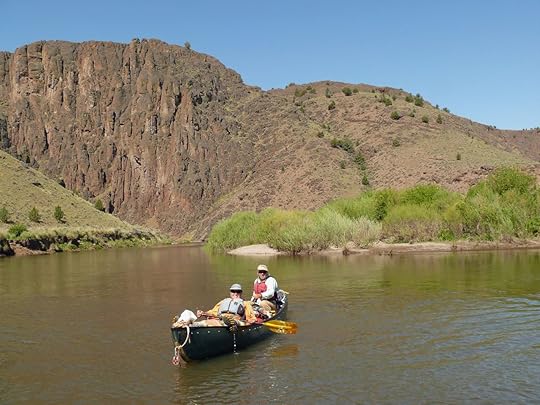
Photo: Roze Petal/Shutterstock
Because the river is snow-fed, the water volume changes dramatically over the course of the season, and sometimes even over the course of a week or two. The section from Rome to Birch has a gradient of 15 feet per mile (fpm) and in most flows is rated Class III. This section has a handful of technical and potentially dangerous rapids, so it’s imperative to have experienced paddlers and guides along.
We recommend flows above 1,000 cubic feet per second (cfs) up to 2,000 for kayaks, and up to 5,000 for rafts. Anything below this could mean walking some sections, as well as a higher risk of pins on rapids. Plus, the river is considerably more technical in low flows because there are more hazards to navigate around. Be sure to check the water gauge before you go to make sure the river is at a safe and navigable volume.
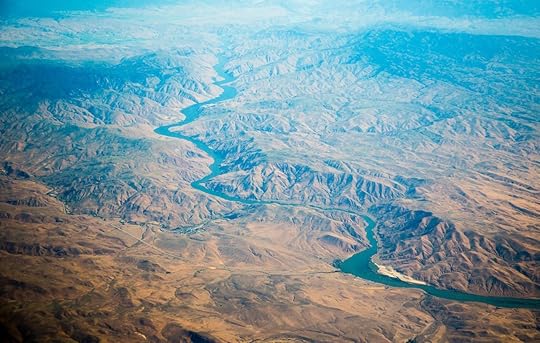
Photo: Bob Pool/Shutterstock
The river starts in a flat, braided section, surrounded by old ranch lands. The first major rapid is Bullseye, 13 miles downstream, a Class IV set. Eight miles downstream you’ll run into Read-it-and-Weep and Artillery Rapids, in quick succession; both are Class III. At mile 31 you’ll run Whistling Bird, a Class IV that’s dangerous at lower flows. We recommend scouting well before running. The most technical rapid on this section of the river is Montgomery, a Class IV that’s both long and complicated. The last few major rapids are Nuisance and Morcum Dam, both around mile 38. These are rated Class IV at lower flows.
Although it’s not renowned for its wildlife, the area is a safe haven for many birds, including golden eagles, hawks, geese, and a collection of songbirds. It’s also not uncommon to see beavers, otters, coyotes, deer, and bighorn sheep as well. Keep a camera handy in your drybag if wildlife spotting is your thing, though the water is often choppy and needs your full attention.
What to pack
Like any expedition river trip, packing the right gear is essential. The Owyhee can be paddled with a hardshell or inflatable kayak, raft, or even a canoe — for those very proficient in whitewater. Every person on the trip should have a personal flotation device, a paddle, a spray skirt, and whistle. Depending on the weather, you’ll also want a dry top to stay warm.
For clothing, you’ll want a sun hat, sunglasses, and buff to wear during the day when the sun is out. Shorts are helpful too, as you’ll find yourself getting wet from time to time. Additionally, bring paddling gloves, a wicking shirt, a warm fleece or puffy jacket, neoprene footwear, and long underwear. Wool socks and a wool hat are ideal as well. Smaller items to bring along include sunscreen, a first aid kit that can pack into your dry bag, insect repellent, water bottle, and water treatment. You’ll want a backpacking setup that can come with you on the river, including camping and cooking supplies like a tent, sleeping bag, stove, cookware, and utensils.
If you plan to fish, bring fishing gear and your permit. Ample springs along the river are easy places to fill up bottles. Keep an eye out for small springs in rocks, all the way down the river. Despite a dry ecosystem, if you stay vigilant, drinking water will not be a problem. We recommend that everyone packs dry bags because of the volume of whitewater and high consequence due to remoteness. A paddle float, paddling knife, bow and stern lines, waterproof maps, sponge, pump, and float bags will keep your boat in order and on the right course. Two-way radios, GPS devices, and satellite text messenger are also highly recommended. 

More like this: 11 insanely cool rafting trips in Colorado you need to take
The post Why eastern Oregon should be your paddling destination this summer appeared first on Matador Network.

Matador Network's Blog
- Matador Network's profile
- 6 followers



